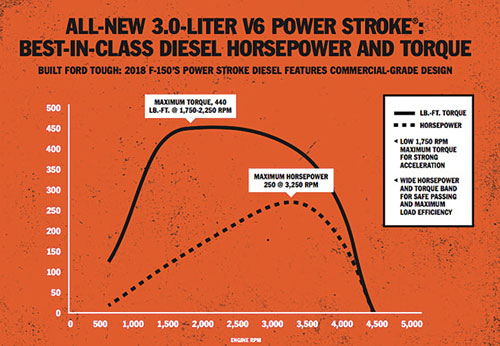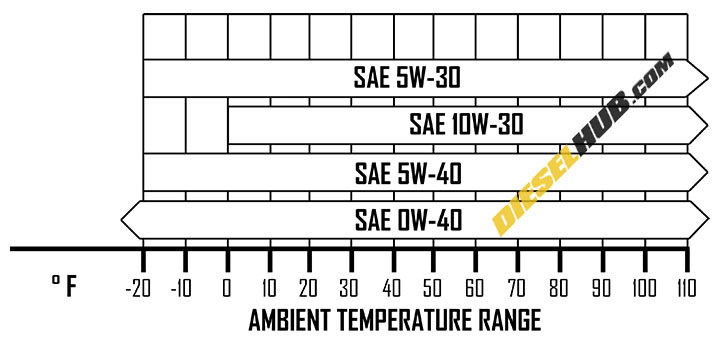After more than a decade of teasing, Ford Motor Company finally introduced a diesel engine option to their flagship F-150 truck line. The 3.0L Power Stroke is a narrow 60 degree, six cylinder vee engine based on the Ford Lion engine platform, which is employed in various European applications. At its peak, the engine achieved up to 22 mpg city and 30 mpg highway fuel mileage, as rated by the EPA.
It competed with the long running 3.0L EcoDiesel produced by FCA and the 3.0L Duramax available in Chevrolet and GMC vehicles. Producing a peak 250 horsepower and 440 lb-ft of torque, the 3.0L Power Stroke trailed both its closest competitors in horsepower, torque, and fuel economy figures (albeit by a small margin). The 3.0L Power Stroke was available in various trims and drivetrain configurations with the exception of the 2021 model year, in which is was only offered in four wheel drive trucks.
Ford Lion Engine Family
Ford's "Lion" engine family includes a pair of V-6 engines produced in 2.7 and 3.0 liter displacements in addition to a pair of V-8 engines displacing 3.6 and 4.4 liters respectively. When news broke that Ford was considering a Lion engine for the Ford F-150, many speculated that the V-8 would be chosen due to its higher power ratings and the importance that performance holds with truck buyers in the U.S. The smaller 3.0 V-6 was ultimately chosen, likely because the larger V-8 could not compete with the fuel economy ratings of competing products in the segment. Lions diesels can be found in various European applications, including cars and small SUVs from Citroën, Peugeot, Jaguar, and Land Rover.
3.0 Power Stroke Retired After 2021
Ford Motor Company's ultimate statement regarding the dissolution of the 3.0L Power Stroke engine option within the F-150's lineup was that the EcoBoost engine platform was exceedingly popular with buyers and the Power Stroke's low sales figures were the source of its demise. While this is presumably accurate, the larger story may be that the 3.0L Power Stroke was not a leading engine within its class; General Motors was leading in horsepower and fuel economy while Ram was leading in torque.
Although it was a close race in the domestic market, Ford was coming in last place. Certainly, the automaker had the capital to invest into the little Power Stroke and dominate the segment, but if EcoBoost powered trucks are outselling the diesel three to one there is little incentive to invest in market domination. For comparison, one could argue that Ford dominates the 3/4 and 1 ton segment with its 6.7L Power Stroke, which has boasted best-in-class titles repeatedly.
The shortcomings of the 3.0L Power Stroke may very well be competing products within Ford's own portfolio, and although we're sad to see it go it doesn't appear that Ford was prepared to give it the attention that it needed to flourish.
3.0 Power Stroke vs EcoBoost - 2021 Model Year Comparison
| 2.7L EcoBoost | 3.5L EcoBoost | 3.5L PowerBoost | 3.0L Power Stroke | |
| Peak Power | 325 hp @ 5,000 rpm | 400 hp @ 6,000 rpm | 430 hp @ 6,000 rpm | 250 hp @ 3,250 rpm |
| Peak Torque | 400 lb-ft @ 3,000 rpm | 500 lb-ft @ 3,100 rpm | 570 lb-ft @ 3,000 rpm | 440 lb-ft @ 1,750 rpm |
| 2WD MPG | 20 mpg city 26 mpg hwy 22 mpg comb |
18 mpg city 24 mpg hwy 20 mpg comb |
25 mpg city 26 mpg hwy 25 mpg comb |
[1] |
| 4WD MPG | 19 mpg city 24 mpg hwy 21 mpg comb |
18 mpg city 23 mpg hwy 20 mpg comb |
24 mpg city 24 mpg hwy 24 mpg comb |
20 mpg city 27 mpg hwy 23 mpg comb |
[1] - 3.0L Power Stroke only available in 4 wheel drive configurations for the 2021 model year.
Since the 3.5L PowerBoost is a full hybrid, it's not necessarily fair to assess the Power Stroke's strengths and weaknesses against this powertrain configuration. However, the long running 3.5L EcoBoost remains the F-150's crown jewel and for the 2021 model year produced a peak 400 horsepower and 500 lb-ft of torque; 60% more power and 14% more torque than the 3.0L Power Stroke. While the diesel offers a significant improvement in highway fuel economy, its combined figures are only 3 mpg (~13%) greater than the EcoBoost powered F-150. Would the average truck buyer sacrifice 60% greater horsepower for a 13% improvement in average fuel economy?
3.0 Power Stroke vs EcoDiesel & Duramax
The following figures represent the maximum available values for applicable 2018 to 2021 model year vehicles. Fuel economy figures are reported and recorded by the U.S. Environmental Protection Agency at fueleconomy.gov.
| 3.0L Power Stroke | 3.0L EcoDiesel | 3.0L Duramax | |
| Peak Power | 250 hp @ 3,250 rpm | 260 hp @ 3,600 rpm | 277 hp @ 3,750 rpm |
| Peak Torque | 440 lb-ft @ 1,750 rpm | 480 lb-ft @ 1,600 rpm | 460 lb-ft @ 1,500 rpm |
| Peak Fuel Economy, 2WD | 22 mpg city 30 mpg highway 25 mpg combined |
22 mpg city 32 mpg highway 26 mpg combined |
23 mpg city 33 mpg highway 27 mpg combined |
| Peak Fuel Economy, 4WD | 21 mpg city 28 mpg highway 24 mpg combined |
21 mpg city 29 mpg highway 24 mpg combined |
23 mpg city 29 mpg highway 25 mpg combined |
Note that at the time of the Power Stroke's retirement, the EcoDiesel led the segment in torque, the Duramax led the segment in horsepower and fuel economy, and the 3.0L Power Stroke failed to claim any best-in-class positions during its tenure. From a competitive perspective, this niche segment is a close race; all two wheel drive vehicles achieved a minimum 30 mpg on the highway and all four wheel drive vehicles were within 1 mpg of each other in highway and combined fuel economy averages.
3.0 Power Stroke Engine Specs
| Engine | 3.0 Power Stroke, 3.0 TDCI, 3.0 Lion Diesel | |
| Engine Family | Ford Lion engine family | |
| Type & Configuration | 4 stroke diesel, 60° V-6 | |
| Applications | 2018 - 2021 Ford F-150 | |
| Advertised Displacement | 3.0 liters, 183 cubic inches | |
| Calculated Displacement | 2.99 liters, 182.76 cubic inches | |
| B10 Life | Not rated | |
| B50 Life | Not rated | |
| Bore | 3.307 inches (84.0 mm) | |
| Stroke | 3.543 inches (90.0 mm) | |
| Bore/Stroke Ratio | 0.93 (undersquare) | |
| Compression Ratio | 16.0:1 | |
| Firing Order | 1-4-2-5-3-6 | |
| Cylinder Numbers |  Cylinders 1, 2, and 3 are located on the passenger side bank; cylinders 4, 5, and 6 are located on the driver side bank |
|
| Engine Block Material | Compacted graphite iron (CGI) | |
| Cylinder Head Material | Aluminum alloy | |
| Injection System | Direct injection, high pressure common rail system Bosch CP4 injection pump (HPFP), 29,000 psi maximum rail pressure, belt driven Piezoelectric fuel injectors In-tank electric fuel-lift pump |
|
| Aspiration | Turbocharged & intercooled Honeywell ball bearing variable geometry turbocharger (VGT) with electric vane position actuator Air-to-air charge air cooler (CAC) |
|
| Reciprocating Assembly | 6 bolt mains (4 vertical, 2 cross-bolt), piston cooling jets | |
| Valvetrain | Dual overhead camshafts (DOHC), 4 valves per cylinder Maintenance free hydraulic lifters Belt driven camshafts (cogged/toothed timing belt) |
|
| Cooling System | Traditional cooling system with mechanical thermostat Belt driven mechanical water pump Mechanical engine driven fan attached to front of engine (behind radiator) Secondary electric fan mounted in front of radiator |
|
| Cold Start Aid(s) | 1 glow plug per cylinder, pulse-width modulated glow plug control module | |
| Engine Oil Capacity | 6.5 U.S. quarts with filter change | |
| Engine Oil Spec | See oil viscosity chart below | |
| Lube Oil Filter P/N | Motorcraft FL2081 (cartridge style) | |
| Fuel | Ultra low sulfur diesel (ULSD), up to B20 biodiesel compatible [2] | |
| Fuel Filter P/N | Motorcraft FD4627 (kit, primary and secondary filters) | |
| Horsepower | 250 hp @ 3,250 rpm | |
| Torque | 440 lb-ft @ 1,750 rpm | |
| Fuel Economy (Peak) | EPA rated 22 mpg city, 30 mpg highway, 25 mpg combined (2018 Ford F-150, 2 wheel drive model) | |
| Emissions Equipment | Cooled exhaust gas recirculation (EGR), diesel particulate filter (DPF), selective catalytic reduction (SCR) w/ diesel exhaust fluid (DEF) | |
| Coupled Transmissions | Ford 10R80 10 speed automatic | |
| Engine Weight | 501 lbs with engine oil | |
| Engine Dimensions | Length | 34.7 inches |
| Width | 30.0 inches | |
| Height | 27.9 inches | |
[2] - Fuel system not rated for biodiesel blends in excess of 20 percent biodiesel, 80 percent conventional ULSD
Horsepower & Torque Curves
At full load, peak engine torque is produced at 1,750 rpm and, according to Ford's torque curve, is maintained until 2,250 rpm. It then appears to taper off slowly as horsepower builds steadily through 3,250 rpm.

Source: Ford Motor Company
Fuel Economy Rating History
The following fuel economy ratings are reported by the EPA. Note that certain configurations and optional equipment may result in lower fuel economy ratings; highest available values are shown for the listed model year and drivetrain configuration.
| Model Year | 2WD MPG | 4WD MPG |
| 2018 F-150 | 22 mpg city 30 mpg highway 25 mpg combined |
21 mpg city 28 mpg highway 24 mpg combined |
| 2019 F-150 | 22 mpg city 30 mpg highway 25 mpg combined |
21 mpg city 28 mpg highway 24 mpg combined |
| 2020 F-150 | 21 mpg city 29 mpg highway 24 mpg combined |
21 mpg city 28 mpg highway 24 mpg combined |
| 2021 F-150 | Not offered | 20 mpg city 27 mpg highway 23 mpg combined |
3.0 Power Stroke Oil Viscosity Chart

SAE 5W-30 and 10W-30 engine oils must meet API FA-4 specifications
SAE 5W-40 and 0W-40 engine oils must meet API CK-4 specifications